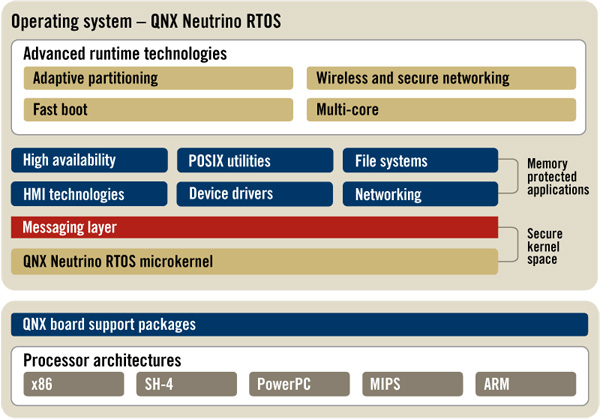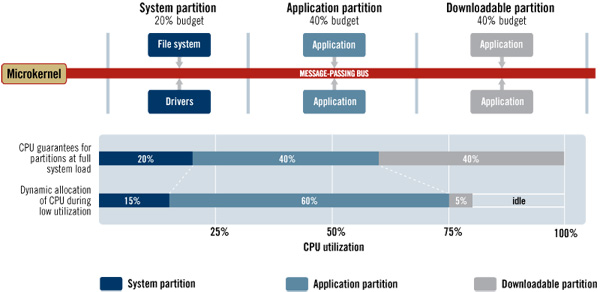The BlackBerry PlayBook Review
by Anand Lal Shimpi on April 13, 2011 9:00 PM EST- Posted in
- Tablets
- Smartphones
- RIM
- BlackBerry
- PlayBook
- Mobile
QNX: The PlayBook OS
A year and a half ago RIM jumped on the opportunity to purchase an OS vendor called QNX (pronounced Que-NIX, like UNIX with a Q in front). RIM saw a growing gap between its BlackBerry OS and what Apple/Google were working on and realized it needed something new to effectively keep up with the joneses. The age old debate between build vs. buy kicked in to high gear and RIM took the route with less internal risk: acquire QNX.
QNX's Neutrino 6.5 OS is the basis of the BlackBerry Tablet OS running on the PlayBook. QNX features a very small (by modern standards) microkernel of around 100K lines of code. By comparison the modern day Linux kernel is around 14M lines of code. QNX argues that by limiting the scope of the kernel it can ensure greater stability and less vulnerability to bugs in the code. QNX is functionally a modern OS, however everything beyond the base kernel is supplied in the form of separate, self contained services. Even drivers are excluded from the microkernel.
QNX is, as a result, a very modular operating system. Additional features are added simply by bundling extra services, however for specific markets you don't incur any complexity or security penalty as unneeded services are simply turned off.
Because it's so modular, QNX has no issues being used in everything from the PlayBook to high end Cisco routers. Obviously the requirements of a tablet are very different from a router, so RIM actually implemented an updated version of QNX 6.5 into the PlayBook with some tablet specific features. The QNX team worked on improving media playback and GPU performance in QNX, features that will eventually make their way into QNX 6.6.
Another benefit of the modularity of QNX is that each service runs effectively sandboxed. A crash within a single service won't bring down the whole OS. Restarting a single crashed service can be done quickly. A small kernel should also be able to boot quicker, however the PlayBook itself has a longer boot time than Honeycomb because the entire OS image is validated using a crytographic hash on boot up. As a result of this image validation, the PlayBook will always boot into a known secure environment. Should the image validation fail, the PlayBook will typically install a previous known-good copy of the kernel stored on a separate partition.
Communication between services/processes happens via a structured messaging system. This is of course one of the benefits of a microkernel OS: inter process communication is usually quite good, because it has to be.
In QNX every task or thread has a priority. While a handful of priorities are reserved for system level events (to prevent an app from taking priority over refreshing the screen for example), everything else is defined by the caller. QNX argues that unlike in monolithic non-realtime OSes, task/thread priorities are nearly always respected here. Inevitably you'll have a number of tasks that have the same priority, and there the scheduler will just round robin between them. The one guarantee QNX offers is that any task with a higher priority will execute in accordance with that priority. This is ultimately what makes QNX a realtime OS.
Large monolithic OSes often give you the same promises, however QNX argues that they don't always hold true to them. There's always some system process that's interrupting things or a runaway task that prevents your screen from updating as quickly as you need it to. These days with hefty multi-core CPU architectures, hiding scheduling latency due to a system process interrupting something else isn't too difficult. On tablets/smartphones it's more of a problem given limited CPU resources, but ultimately it'll diminish there as well. There is arguably a power efficiency benefit here but at a high level that's a difficult thing to measure.
The QNX OS itself has been ported to everything from x86 to PowerPC. Although the PlayBook uses an ARM based OMAP 4430 today, it looks like RIM is pretty open to moving to other microarchitectures should the need arise.
File System
On the PlayBook RIM implements the latest version of the QNX file system. The setup supports 64-bit LBAs (effectively no limit on single file size given current NAND capacities) and 1K file names.
File system performance is difficult to measure at this point given that we're dealing with pretty low performance NAND as well in devices like the PlayBook.












77 Comments
View All Comments
gentrfunk - Saturday, April 16, 2011 - link
Hi Folks,Anyone have any info on how messages are passed back and forth between the kernel? I'm interested in the fact that microkernel systems typically had problems in some cases locking up the cue with multiple rapid input (e.g. mouse clicks, etc)...
any thoughts?
mavricxx - Tuesday, April 19, 2011 - link
The thing about this tablet is that you gotta give it time to mature. Right now is at its infant state where there are little apps, and the software is still being refined. I will say that the best thing about this tablet that sets it apart from Android is that you won't have different iterations of say Honeycomb 3.0 and having to wait forever for updates. One good thing RIM has going for it is its reputation for kicking out updates. Hopefully, it kicks it in turbo and lots of GOOD apps start coming out. Another thing I'd like to point out that NONE of the reviews have applauded RIM for is the standard MicroUSB charger which all phones use now a days. This is a big deal as if you happen to lose your charger its no big deal. I hope to see a lot of cool and useful gadgets for this device as well. One major thing I see that RIM screwed up besides the whole email/calendar/contacts thing was the absence of expandable memory; Had they added a FULL size SDXC card support they would have blown this thing to another level. A couple of things I'd like to see with the upcoming updates are: Free turn-by-turn Nav, universal search and maybe some full free FPS(Call of duty)/racing(need for speed)/action(Grand theft auto)/RTS(Company of heroes) games to make this thing worthwhile to buy. Lastly, I think RIM could have made this thing more desirable to purchase as well by including headphones, USB adaptor and an HDMI adaptor.worldbfree4me - Tuesday, April 19, 2011 - link
This year, Tablets will probably be only 2nd to HDTV's in Black Friday advertising. I like my iPad 1, but it is lacking in a lot of areas. I think that the features I crave on the HTC View (Stylus Input), Black Berry and HP WebOS (Bridge), and True Multitasking will eventually find their way onto the rest of the pack and by this time next year we will finally see complete Tablets with I/O galore (HDMi Mirroring,USB 3.0, BT 3.0, MicroSD etc). With Amazon leading the Cloud Storage Charge, on device storage will become not so this keeping retail prices nominal. Even right now because of my distrust in Apples’ walled garden. I have no Music or Videos stored locally on my iPad. Sugar Sync, Evernote, Drop Box, and of course Gmail rounds out my storage albeit virtually.Thanks for another great analysis!
mblair - Wednesday, April 20, 2011 - link
The RIM playbook is a game changer. The slick, easy to use interface and true multi-tasking make it a dream to use. Its Flash execution is flawless. I was surprised how many times I needed Flash. It made my Ipad almost useless some of the time.The best feature for me is Blackberry Bridge. A Wi-Fi tablet but with my blackberry in my pocket and Bluetooth, I can operate 3G. I can't do that with my Wi-Fi only Ipad! And I don't need two user accounts or an extra monthly fee.
It did not take me long to get used to the Blackberry paradigm. Now I take it everywhere, it is small enough to be truly portable. Battery life is OK, not spectacular but pretty good. The video rendering is world class.
I use gmail so the browser is all I want or need most of the time. I have my Blackberry for email from work and when tied to the Playbook I can use the larger screen seamlessly. The Playbook gives me all I want.
Good bye Apple. It has been a slice.
I love it. I have given my son the Ipad. He wants a Playbook. Maybe later.
Michael Blair
Shadowmaster625 - Friday, April 22, 2011 - link
This is a screenshot from a flash game running on IE9: http://grab.by/9WxQThere are huge gray sections that are failing to render or whatnot. The sections grow over time. It looks really bad. This doesn't happen on firefox. But the game does run faster on IE9, for whatever that is worth... obviously not much.
exprimarelibera - Monday, July 18, 2011 - link
I bought one today, more than four months after this article and still no email application available. I'm pretty disappointed, after all that's what made RIM what they are.http://www.exprimarelibera.ro/2011/review-m-am-juc...
No Netflix Streaming - Sunday, November 27, 2011 - link
This tablet DOES NOT STREAM NETFLIX. The Netflix app only queues discs. Contact Blackberry Before You Buy and Demand a Netflix Streaming App.